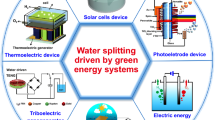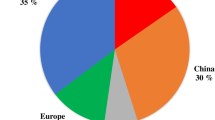Abstract
Current wastewater treatment (WWT) is energy-intensive and leads to vast CO2 emissions. Chinese pledge of “double carbon” target encourages a paradigm shift from fossil fuels use to renewable energy harvesting during WWT. In this context, hybrid microbial photoelectrochemical (MPEC) system integrating microbial electrochemical WWT with artificial photosynthesis (APS) emerges as a promising approach to tackle water-energy-carbon challenges simultaneously. Herein, we emphasized the significance to implement energy recovery during WWT for achieving the carbon neutrality goal. Then, we elucidated the working principle of MPEC and its advantages compared with conventional APS, and discussed its potential in fulfilling energy self-sustaining WWT, carbon capture and solar fuel production. Finally, we provided a strategy to judge the carbon profit by analysis of energy and carbon fluxes in a MPEC using several common organics in wastewater. Overall, MPEC provides an alternative of WWT approach to assist carbon-neutral goal, and simultaneously achieves solar harvesting, conversion and storage.

Similar content being viewed by others
References
Izadi P, Yu E (2020). Realizing full potential of bioelectrochemical and photoelectrochemical systems. Joule, 4(10): 2085–2087
Li M, Wang H, Luo W, Sherrell P C, Chen J, Yang J (2020). Heterogeneous single-atom catalysts for electrochemical CO2 reduction reaction. Advanced Materials, 32(34): 2001848
Lu L, Guest J S, Peters C A, Zhu X, Rau G H, Ren Z J (2018). Wastewater treatment for carbon capture and utilization. Nature Sustainability, 1(12): 750–758
Lu L, Li Z, Chen X, Wang H, Dai S, Pan X, Ren Z J, Gu J (2020). Spontaneous solar syngas production from CO2 driven by energetically favorable wastewater microbial anodes. Joule, 4(10): 2149–2161
Lu L, Vakki W, Aguiar J A, Xiao C, Hurst K, Fairchild M, Chen X, Yang F, Gu J, Ren Z J (2019). Unbiased solar H2 production with current density up to 23 mA·cm−2 by Swiss-cheese black Si coupled with wastewater bioanode. Energy & Environmental Science, 12(3): 1088–1099
Lu L, Williams N B, Turner J A, Maness P C, Gu J, Ren Z J (2017). Microbial photoelectrosynthesis for self-sustaining hydrogen generation. Environmental Science & Technology, 51(22): 13494–13501
Nguyen P D, Duong T M, Tran P D (2017). Current progress and challenges in engineering viable artificial leaf for solar water splitting. Journal of Science: Advanced Materials and Devices, 2(4): 399–417
Qu J, Ren H, Wang H, Wang K, Yu G, Ke B, Yu H Q, Zheng X, Li J (2022). China launched the first wastewater resource recovery factory in Yixing. Frontiers of Environmental Science & Engineering, 16(1): 13
Qu J, Wang H, Wang K, Yu G, Ke B, Yu H Q, Ren H, Zheng X, Li J, Li W W, Gao S, Gong H (2019). Municipal wastewater treatment in China: Development history and future perspectives. Frontiers of Environmental Science & Engineering, 13(6): 88
Yang E, Omar Mohamed H, Park S G, Obaid M, Al-Qaradawi S Y, Castaño P, Chon K, Chae K J (2021). A review on self-sustainable microbial electrolysis cells for electro-biohydrogen production via coupling with carbon-neutral renewable energy technologies. Bioresource Technology, 320(Pt B): 124363
Acknowledgements
This work was financially supported by the State Key Laboratory of Urban Water Resource and Environment (Harbin Institute of Technology, China) (No. 2021TS13), the National Natural Science Foundation of China (No. 22176046) and Shenzhen Science and Technology Program (China) (KQTD20190929172630447 and JCYJ20210324124-209025).
Author information
Authors and Affiliations
Corresponding author
Additional information
Highlights
• Mitigating energy utilization and carbon emission is urgent for wastewater treatment.
• MPEC integrates both solar energy storage and wastewater organics removal.
• Energy self-sustaining MPEC allows to mitigate the fossil carbon emission.
• MPEC is able to convert CO2 into storable carbon fuel using renewable energy.
• MPEC would inspire photoelectrochemistry by employing a novel oxidation reaction.
Rights and permissions
About this article
Cite this article
Li, Z., Lu, L. Wastewater treatment meets artificial photosynthesis: Solar to green fuel production, water remediation and carbon emission reduction. Front. Environ. Sci. Eng. 16, 53 (2022). https://doi.org/10.1007/s11783-022-1536-5
Received:
Revised:
Accepted:
Published:
DOI: https://doi.org/10.1007/s11783-022-1536-5




